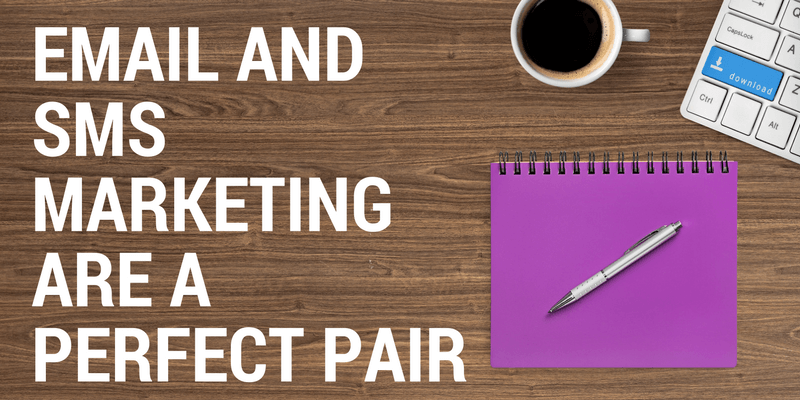Email and SMS Marketing are a Perfect Pair

Businesses with limited staff or budgets might ask themselves whether they should use email or SMS marketing. Both are relatively low cost. Furthermore each offers the ability to reach many people at the same time, yet provide personal interaction. SMS and email have a long history of being used for marketing.
The reason though, that it’s hard to decide is because they both work. But they are each good at different things. And that’s why they complement each other really well. So perhaps the only decision to be made is to use both of them.
For example, emails are great for longer content or extended campaigns. Statistics from Hubspot show that sending 16-30 email campaigns a month results in the highest click through rates. If you send that frequently, you can expect open rates of about 32% and click through rates of just over 6%. Not too bad for emails actually considering how full the average email inbox is. That’s why just sending one or two emails isn’t enough anymore – you need to keep your email in front of users.
In contrast, SMS messaging is better for short content. Open rates are at or above 99% and click through rates can average 36%. But users expect fewer messages via text. If you send more than six per month, users will start identifying you as spam or unsubscribe. So for text messaging, you send less often and only when the message is relevant or important to the users.
Given their differences described here, you might still think it’s ok to use one or the other. And of course it’s ok to do that, but if you can coordinate and use them both you’ll likely get better results than using just one. Here are the a few examples of how to use them together.
Double opt in campaign
Both email and SMS marketing are permission based. So you’ll need to get consent to send either. But once you have someone on one list, you can start promoting the other list. For example, you can ask someone in an SMS message for their email so they can join your email list. They can reply directly with their email, or you could send a link where they can sign up on a mobile friendly website.
Alternatively, if someone signs up for your email list, you can ask them to sign up for your SMS list.
You can send specific emails about your SMS marketing, or you can include a call to action at the end of each email to sign up. This could be in the signature, or as a banner ad within the email.
Whichever way you cross-promote your opt in, always make it clear why someone might want to join your SMS list when they already get email or vice versa. There has to be a benefit to both that is exclusive to each so someone would actually want to get that many messages from you two different ways.

Now put the lists to work
Once you have someone on both your lists you can use them together to promote sales, keep in touch, or follow up for customer service.
Let’s look at an example where you send a sales campaign via email with pictures and lots of detailed information designed to get them to click, visit a store, or enquire for more information. If the sale has a limited time, then follow up the email with an SMS. For example, the text could say something like, “Just 8 hours left in our weekend sale! Follow this link to get 20% off: [link]”.
The text message is a timely alert to a limited offer that is fully explained in the emails you’ve been sending. I don’t know about you but I often forget about a sale I saw in an email, even if it is something I’m interested in (If it’s something I need I’ll probably remember more often). A text alert might just be the thing to get someone to buy during the sale when they otherwise wouldn’t.
Another use would be if they had visited your website for the sale, but abandoned their cart. You could send a text saying “You forgot something! The sale for items in your cart ends today! Follow this link to return to your cart and get them before the price goes up. [link]”
Real life example of using SMS to grow an email list
Chuck E. Cheese’s is a franchised chain of children’s arcades and pizza restaurants in the U.S. The company placed advertising in the restaurant asking people to text their email addresses to a shortcode to sign up for email offers.
The program has been so successful that 5% of new email registrations come from the text message opt in. The company analysed the statistics of SMS opt ins versus other opt ins and found that the SMS ones had open rates of 10-20% higher than those that signed up another way. Also, the SMS opt ins clicked on the email coupons almost 10% more often too.
While they aren’t using explicit SMS marketing yet (though they are using SMS opt in data for marketing analysis), they do have all those mobile numbers they could follow up with to see if they wanted to receive SMS marketing too. Given the increased performance of the SMS opt ins, I’d bet they’d also love to get SMS coupons too.
The dual benefit to you
The benefit of having the same person signed up on both lists is that you can contact them on both channels. If they opt out on one, they will still be on the other. Depending on the reasons why they opted out of one list, you might even get them to sign back up after a time if you can prove the benefit outweighs the reasons they unsubscribed before.
Text messaging and email are both great ways to market to people, but they each have their own strengths and weaknesses. Together they make a perfect pair, don’t you think?
Related Articles
5 Top Converting Power Words for SMS Marketing
How to Capture the Essence of Autumn in Your SMS Marketing Campaign
What Your Customers Want From SMS Marketing
Mobile marketing offers an unprecedented access to your customers virtually any time, anywhere. This is particularly true for SMS marketing because it is “always on”. Customers don’t have to be surfing the web, or using an app to receive messages. Instead, they see the marketing messages right alongside ones from their friends and family.
How to Use SMS Marketing to Counter Retail Fatigue
Uncertain economic times and an ever-extending holiday retail season is apparently making Brits less excited about the “usual” sales. But don’t worry, find out how SMS marketing can help you boost sales even in the face of retail fatigue.
Do Your SMS Marketing Messages Sound Spammy?
If you aren’t seeing a positive response from your SMS marketing then your list may be thinking of it as spam and just ignoring it like they do much of their email. So take your latest marketing messages and examine them again with these four questions in mind.
Is Your SMS Marketing Keeping Customers Loyal by Being Fun?
When you think about your SMS marketing campaigns would you label them as fun? Is there any aspect of your SMS marketing or loyalty program that you think customers would call fun? If so, you're going to love what you read in this blog. If not, then you need to read this blog. It turns out that a little bit of fun and games can keep your customers more engaged – and more loyal.
9 SMS Marketing Power Words
With its 456 character limit, SMS Marketing challenges us to be succinct, ensuring we pack the most into our punch and deliver powerful and effective calls to action in a minimum of words. With some research and planning, it is still possible to craft great messages that get results and still stay well within the limits. In this article, we share 9 power words and phrases to help to you do just that.
5 SMS stats to excite any business about SMS
5 SMS Marketing Ideas for Valentine’s Day [Infographic]
How Entertainment Venues Can Use SMS Marketing
Whether it's a cinema, theatre or concert hall, your entertainment venue is missing a trick if it's not utilising SMS marketing to get those bums on seats. We take an in-depth look at how all kinds of entertainment venues can really make the most of SMS marketing.












